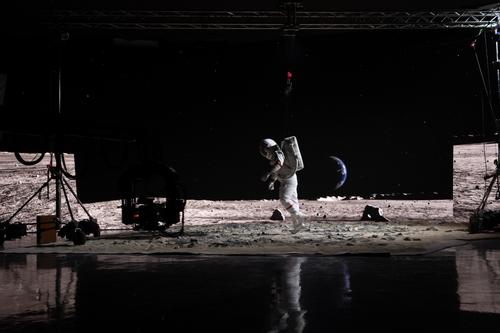NAB Show Daily - Advances in Production
Over the last 18 months, the boom in virtual production has shaken up the way filmmakers, broadcasters, mobile video designers and more conduct their creative business. Those technologies enabling virtual production include augmented reality (AR), virtual reality (VR), extended reality (XR) and mixed reality (MR). Susan Ashworth of TV Tech reports for the NAB Show Daily Day1 edition.
Green Screen Comes to the Lecture Hall

Virtual reality is enlivening the lecture hall. The University of the Netherlands worked with Zero Density to create a massive virtual lecture hall using the company’s Reality Engine real-time broadcast compositing system.
Using the virtual space, scientists and professors have access to interactive storytelling techniques and advanced visualization methods — complete with real-time realistic reflections and refractions of physical objects and people inside the green screen. Professors are able to explain complex matters on a large virtual screen or run physical experiments with immersive real-time graphics.
The space employs Grass Valley LDX 86N 4K cameras alongside Mo-Sys camera tracking technology while the green screen lecture space itself runs on two Reality Engines.
London Welcomes Virtual Production

When Garden Studios in London finalized its virtual production stage in 2021, the result was a 4,800-square-foot space that could serve as a cost-effective filming option with unique creative opportunities. The new virtual production studio at Garden Studios allows filmmakers to shoot real-time virtual effects on set by using virtual graphics displayed on an LED volume (an enclosed space where motion capture and compositing can take place) to create photo-realistic backdrops.
Among the technologies in place are the VP Pro XR server and StarTracker camera and lens tracking systems from Mo-Sys Engineering. Features within the VP Pro XR are an Unreal Engine editor interface and feature known as Cinematic XR Focus that allows a filmmaker to pull focus between talent or objects in the physical studio and virtual objects positioned in the LED volume.
According to the company, this means that an LED volume can be used as more than just a backdrop but rather can deliver better interactivity between real and virtual elements. Jillian Sanders, virtual production coordinator for Garden Studios, said the Mo-Sys team came to the studio for a multitude of tests including displaying digital tracking markers on the studio’s LED ceiling.
“We’ve also been able to assist with testing and development of their new VP Pro XR,” she said. “This exciting new tool allows for features such as digital set extensions, the ability to focus past the LED wall into the digital world, and near time rendering.”




